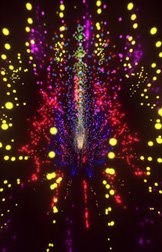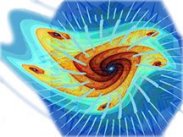Sudden Climate Change
 Wednesday, February 8, 2006
Wednesday, February 8, 2006 
Butterfly/Lorenz Attractor from the Chaos and Culture class website of Prof. Tom LoFaro, Gustavus Adolphus College
In the final article of the 3-part Inquirer Series on the Gulf Stream that appeared in December 2005, the connection with Chaos was at least implied. (See my earlier post on the surprising lack of chaos in the first two parts of the series.)
The article chronicles the discovery by Richard Alley in 1992 of extremely rapid temperature shifts of up to 15 degrees within a 30 year time span. Such a rapid temperature change today would lead to world catastrophe (regardless of whether the earth was cooling or warming).
Alley was investigating core ice samples in Greenland. Remarkably, based on the depth of the samples, he measured this rapid temperature shift as occurring approx. 12,000 years ago . The culprit? You guessed it - Ben Franklin's Gulf Stream.
The connection with chaos is obvious to anyone who understands the separate wings of Lorenz's butterfly. As the trajectory that describes the state of the weather moves around one wing, it will suddenly flip over to the other wing - a sudden reversal that "just happens."
As the Inquirer article points out, "until the 1950's, climate was viewed as essentially a stable system."
Lorenz, Alley, and many others have certainly shown otherwise.









